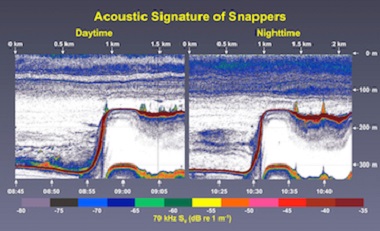380915-soundscapes.jpg

Typical acoustic signatures of bottomfish, during day and night surveys. Credit: National Oceanic and Atmospheric Administration, Reka Domokos
The oceans are getting louder. Fish and mammals grunt, click, and chirp to attract mates, threaten rivals, or just say “howdy.” At times, though, they can be overpowered by the sounds created by humans. It’s enough to drive a fish to distraction.
To understand just how distracting human-made noise can be, scientists first must understand how marine organisms deal with the natural “soundscape” — the sounds produced by the creatures themselves. A recent study, for example, found that fish seem to talk over each other during the daytime, but share the soundscape at night.
Researchers placed microphones in an underwater cave on the coast of South Africa, and recorded for several months. When they analyzed the recordings, they isolated sounds made by different species.
They found that during the daytime, different species of fish produced sounds at overlapping frequencies — like several people talking at once. But the species that were busiest at night communicated at different frequencies.
The researchers suggest that during the day, fish can add visual cues to their communication. Some fish nod up and down when they’re courting, for example. That means they don’t need to rely so heavily on sound. At night, though, visual cues don’t work. So nocturnal species “talk” at different frequencies — some species produce a high pitch, some a low pitch, and some are in the middle. That makes it easier to get their message across in the noisy ocean depths.

